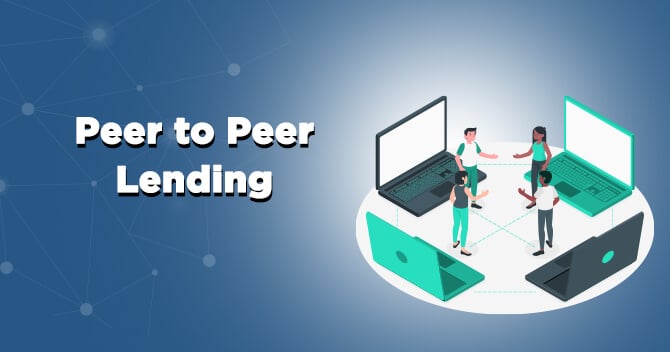Peer to Peer lending provides an alternative to the borrower to taking out a traditional loan from a bank. This is a kind of lending online platform where loans can be raised and paid back along with a prescribed rate of interest, usually lower interest rates. Here, the borrower can be either an individual or can be a legal entity.
RBI is the regulatory authority for P2P lending companies. Peer to Peer lending is a system of lending and borrowing without involving any bank or any other financial institution lender.
What is Peer to Peer Lending?
Peer to Peer lending, a technology-driven system, which is a much easier lending platform as compare to Banks and non- banking Financial Companies (NBFC). P2P lending offers borrowers an easy solution to borrow money for short term requirement. The short term requirement could be for buying consumer electronics; medical emergency repays credit card dues or business loan.
- It’s a form of crowd funding used to raise loan for people who need to borrow, from those people who are interested in investing their money.
- It empowers individuals or nay legal entity to borrow or lend money without any bank or financial institution engaged in the lending process, as a negotiator.
- P2P lending also extends credit borrower, who was unable to get it through traditional financial institutions.
- At such a platform, both lender and borrower seek benefits. Saver gets higher interest by lending out their money instead of saving it, and for the borrower, it’s easy for them to get funds at the comparatively low-interest rate.
Features of Peer to Peer Lending
The following characteristics are discussed to define a Peer to Peer lending Platform:
- Peer to peer is a complete online portal that connects the borrowers with the lenders.
- At this platform, there is no such requirement of developing relationship between lender and borrower before lending and borrowing process.
- One of the best features of P2P lending is that there is no involvement of financial Institutions or an intermediary between borrower and the lender throughout the process.
- Further, the borrower and lender have their own terms and conditions, having the flexibility to make a choice of borrowing and investments, respectively.
Forms of Peer to Peer Lending
- Student Loans;
- Secured Business Loans;
- Commercial and Real Estate Loans;
- Crowd Lending, i.e. they are the unsecured personal loans they are generally offered to individual, company or charity.
Benefits of Peer to Peer Lending
P2P loans aren’t always better options than loans from traditional banks and financial institutions, but they are typically competitive.
Low Interest Rates:
An individual can generally borrow from P2P lending platform and that too on low rate. The low interest rate makes P2P borrowing a better deal as compared to banks and credit cards. But comparing the interest rates is always a worth since individual should pay attention towards the promotional rates along with determining whether you can pay off the debt quickly or not.
Origination fees:
There is an originated fee varying from 1 to 5 percent to fund the loan with the P2P lender. This originated fee depends upon the loan amount borrower have applied for. As compared to banks, the fee banks charges is higher than an originated fee of P2P Lending.
Quick and easy:
Getting your loan approved is pain and risky. After applying for a loan through banks, a borrower has to wait for the approval. Besides this, such waiting pain is eased. The process is quite simple and quick, and often borrower can find out whether his/her loan is getting approval or not. Furthermore, actual funding can take a long time, as an investor needs to choose whether he wants to put money towards borrower’s loan or not.
Able to access lower rates
Peer to Peer lending offers loan to borrower at a very low interest rate, if compared to traditional lenders like banks. This happens as investors are providing money directly to borrowers through a P2P platform, which often allows both parties to benefit from more favourable rates.
Another option for a loan to traditional lenders
Borrowers those are looking for an alternative option to traditional banks a peer-to-peer loan provides a great alternative.P2P platforms now a accomplish an important role for those looking towards alternative finance for some of their many financial needs.
What is the Funding Process under P2P Lending?
Via following modes Peer to Peer lending can be processed;
Auction
Under this mode, the lenders shall compete with each other to fund the loan requirements of the borrower through offering loan at comparatively at low rates on interest. The borrower can then choose the lender who fulfills his/her loan requirements completely. Here at this platform, borrower can also borrow more than one loan from different lenders depending on the amount of the loan and the rate of interest.
Fixed Rate Auction
Fixed Rate Auction, as a name by itself suggests, the loan amount has to be funded by the lender while the rate of interest remains fixed. This method is known to be one of the convenient methods for lender.
Marketplace Model
Under this method, borrower underwrites the loan requirement. Once the loan amount has been mentioned, loan ID will be generated, and the same will be shared the lender also. If the requirement suits to the lender he further can lend loan to the borrower.
How does peer-to-peer lending work?
The process of Peer-to-peer lending is fairly straightforward. All the transactions take place through an online platform.
Below mentioned steps below describe P2P lending process:
- A potential borrower willing to obtain loan from P2P platform completes an online application on the peer-to-peer lending platform.
- After assessing the loan application, along with determining the risk and credit rating of the borrower, interest rate will be assigned to the borrower.
- Once the application gets the approval, the borrower receives the options available to him based in his credit rating through investors.
- Now, borrower can evaluate the available options and can choose anyone from them.
- Borrower becomes responsible for paying regular payment (mostly monthly), interest payments.
What are the advantages and disadvantages of peer-to-peer lending?
There are significant advantages to both borrowers and lenders:
Gives high returns to the investors, as compared to other investments;
Peer to Peer lending license provides higher returns to the investors, relatively if invested in any other type of investment.
An easy source of funding:
Peer to Peer lending is the more accessible source of funding than other traditional loans from banks or any other financial institution. The reason behind this is by the low credit rating of the borrower.
Lower interest rates:
At P2P platform, interest rates are usually low, because of the great competition between the lenders available in market, along with this it offers a lower originated fee.
Read our article:Is it Necessary for the Companies Dealing in Financial Activities to Obtain an NBFC License from RBI?
Here are a few disadvantages of P2P lending;
Credit risk:
One of the biggest disadvantages of peer to peer loan is the default on the part of borrower. Many borrowers who were not eligible for the loan from traditional way, applies from P2P lending platform. Here, in such a scenario a lender should be aware of the default probability.
No insurance/government protection:
At this platform, government does not provide any protection or insurance to lender, if the borrower commits any default.
Legislation:
At some places, Peer to Peer lending is not allowed; else if any company still wishes to provide lending service needs to comply with the investment. So, this can be possible that peer-to-peer lending may not be available to some borrowers or lenders.
What are the types of P2P Lending?
Following mentioned are the principal types of P2P lending;
1. Consumer Lending
- Where the P2P lending industry commenced ;
- Small, unsecured loans to borrowers;
Mostly used for;
- Funding purchases, for example, weddings, cars, holidays or home essentials;
- Debt consolidation from other more expensive forms of credit, such as credit cards
2. Property Lending
- Loans to Limited Companies or individuals
- All loans are secured by a 1st legal charge over a residential or commercial property, which is registered at the land registry
- If the borrower fails to repay, the platform can repossess and sell the property in order to redeem the loan
- This is, therefore, a less risky alternative to lending to a consumer or SME business[1] with no bricks & mortar security
- Platforms use third party professionals to value the property and to ensure clear title over the property
3. SME Business Lending
- Small loans to trading Limited Companies;
- Loans can be unsecured or secured against a Company’s assets or personal guarantee from shareholders or directors;
- The risk with lending to SMEs is that the company could go into bankruptcy
- Most frequently used for:
- Working capital;
- Business expansion;
- Asset finance.
What is it Safe to Borrow with P2P?
P2P lending is a safe platform, and consumer friendly;
- Consumer Data: Most of the popular Peer to Peer lender keeps consumer data secured, just like any other financial institution. All the communications take place through a secured browser session.
- Privacy Policy: Usually, the identity of lender and borrower should be kept confidential. But it’s always a wise decision to review privacy policies to understand what information investors receive. Institutions might have right share information for loan processing.
- Interest Rates: On this platform, interest rates are quite competitive with what can be found elsewhere.
Conclusion
Peer to Peer lending is an innovation to traditional financial loan being followed from such a long time. If the procedures between P2P lending and bank loan is compared, we can conclude that;
- The procedure in P2P lending is more transparent and frequent. It offers more privilege to user in choosing the lending manner and lending objects.
- P2P lending uses different credit auction method, different from conventional loan method. It depends upon the information available on online platform.
- One drawback is that loan management is not good at P2P lending. As it does not follow the traditional method to disburse loan, and does not track the post – loan information on borrowers.
Read our article: NBFC Registration – Know the Entire Incorporation Procedure











